by Ken Lain, the mountain gardener

At the Lain house we like to remind ourselves of those who have made indelible differences in our lives. In addition to memorials for people, we love to plant a tree in memory of the animals in our lives, especially our dogs. You will know the canine memorial tree in our yard by the collars hanging from its branches!
Remembering family members is essential, and planting a memorial tree is the perfect token of remembrance.
No matter which month commemorates that special someone, during the week leading up to Memorial Day Watters is featuring the perfect trees for memorials. Each is the variety that looks its best in a specific remembrance month.
For example, The tree for a May memorial is the Purple Robe Locust. Covered with wisteria-shaped purple flowers, it’s known for its longevity, deep summer shade, fire-wise stature, and low water use.
Here are the trees that were chosen for each month. See all 12 on Watters Pinterest Board. https://goo.gl/JVhXDL
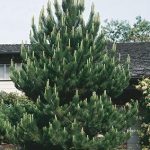
January – Austrian Pine (Pinus nigra) A resilient evergreen pine amenable to poor soils and alkaline conditions. It’s remarkably tolerant of hot and cold mountain winds and is a crucial component in shelter belts and windbreaks. Adapts well to dry conditions of Arizona, both in semidesert and mountain foothill regions where soils are thin and poor. Makes a very graceful single specimen for front yards, parks, or expansive estate-sized landscapes. More on Austrian Pine.
February – Aspen (Populus tremuloides) A superior tree for cold northern Arizona regions. It is most attractive in groves, and as components in windrows and shelter belts. It will stand alone as a columnar tree in a suburban environment, where its tall narrow form is ideal for filling gaps between tall buildings. Well suited for street and boulevard planting. An excellent foreground tree against the dark background of evergreen conifers. Ease of cultivation is suited to naturalistic plantings in prairies or open space habitats. More on Aspen Trees.
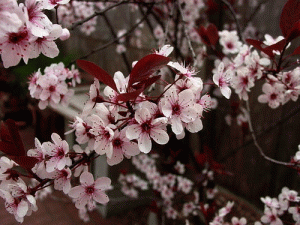
March – Thunder Cloud Purple Plum (Prunus cerasifera) In spring it delivers a storm of color in a surge of pink blossoms, reminiscent of a cherry tree in full bloom. As the flowers fade, royal purple leaves emerge, producing a shade tree for the summer. Its purple leaves are in striking contrast against the jewel box yellows and reds of other autumn leaves. It is very hardy and thrives anywhere, but the best purple leaf color is to be had in full sun. More on Purple Leaf Plum Trees.
April – Crabapple (Malus) An outstanding flowering tree with an upright form that becomes rounded with age. Reddish new foliage matures to dark green. Lovely deep pink flowers produce persistent, small, dark, red-purple fruit. A colorful accent for smaller landscapes. More on Prairefire Crabapple.
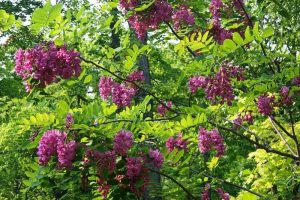
May – Purple Robe Locust (Robinia) Grows just about anywhere it’s planted. A fast-growing tree that thrives in tough, barren, even sandy, soils. You can count on hundreds of purple wisteria-like flowers to cover this tree every Mother’s Day, filling the yard with a heavenly scent that is bound to bring back memories. More on Purple Robe Locust.
June – Golden Locust (Gleditsia) Is proven as a hardy street and shade tree, being fast-growing, heat and drought tolerant, and well-suited for the demands of mountain landscapes. It grows with an open, spreading canopy with attractive, elegant, somewhat weeping foliage. The ‘Sunburst’ variety is thornless, a versatile small to medium size, and is distinctive for its color – bright yellow shoots turning to yellow-green and yellow autumn colors. More on Sunburst Honey Locust.
July – Mountain Magnolia (Magnolia grandiflora) Its lustrous, leathery foliage is a rich, dark green topside and cinnamon brown underneath. Large, 5-6″ creamy white flowers are exotically fragrant. A hardy magnolia that transplants well and does not lose as many leaves as other varieties, it exhibits evergreen-like cold tolerance. More on Magnolia Trees.
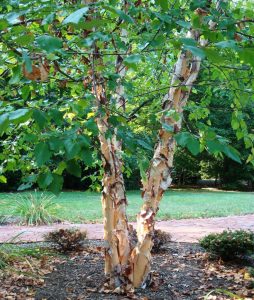
August – Birch (Betula utilis) This tree is far superior to the Aspen in heat and drought tolerance. Its densely pyramidal form is comprised of glossy green leaves that fade to clear yellow in autumn. Plant as a large tree for a focal point that will shade its surroundings. Will make an excellent narrow front yard tree for areas with limited space. It’s a natural around water gardens and dry streams. Used in mixed forest groves, its white bark adds striking eye-catching interest. More on Birch Trees.
September – Ginkgo (Ginkgo biloba) The leaves are an exciting fan shape that flutters in the slightest breeze. Green foliage turns brilliant golden yellow in fall. Ginkgoes have been known to live 1,000+ years, having grown since the time of dinosaurs. More on Ginkgo Trees.
October – Blazing Red Maple (Acer x freemanii) Its upright form has a perfect branching habit, and is very fast growing. An excellent lawn, park, or street tree that easily withstands mountain winds. The fastest growing of the red maples, it boasts brilliant, long-lasting, red, Fall foliage. More on Blaze Maple.
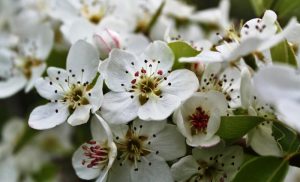
November – Aristocrat Pear (Pyrus calleryana) Vigorous and upright with a dominant central trunk, it’s excellent for lining streets and drives, or as a specimen for smaller spaces. Adapts to a wide range of soils, including heavy mountain clays. Bridal-white flowers in spring, disease-resistant glossy green leaves with a unique wavy edge. The last tree that turns red in autumn. More on Aristocrat Pear.
December – Fat Albert Spruce (Picea pungens) A superb evergreen conifer with rich blue needles on a densely branched, naturally pyramidal form. An outstanding landscape specimen. A very slow grower that can become quite large over time. The only choice for use as a living Christmas tree! More on Fat Albert Spruce.
There you have the List and Watters can Plant and Deliver it for you as well.


